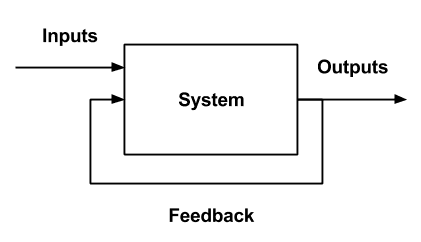We are in the 21st century and feedback is still a difficult subject in organizations. Ask anyone: virtually every company will claim they would like to have a culture with more feedbacks. But what is really feedback? How are organizations addressing this issue? Should it be anonymous? We hope to answer these questions in this text. ;)
Definition
In a system, a feedback occurs when the output is redirected to one of its inputs and consequently changes the output again. Like this:
The same goes for people and organizations. Our behaviors (outputs) influence the environment, which gives us some feedback, which we perceive through our senses (inputs), which in turn influences our behaviors again.
What your boss says to you is feedback. Body language can be feedback. The metrics for your product are feedback. All we sense is feedback.
Even lack of feedback is feedback.
Types of Feedback
In organizations it is common to see the feedback being divided into two groups: positive and negative. The compliment and the scolding. We propose a different classification, just to remove the misunderstanding that negative feedback is bad and positive is good.
The first is reinforcement feedback (the old positive). It tends to amplify the output, until some other mechanism prevents it. For example, if you received a compliment from some colleague that you are being helpful, you tend to be even more helpful. At least until some other mechanism kicks in, like your own conscience, saying that you do not have to be even more helpful or have other priorities.
The second type is equilibrium feedback (popularly called negative). This tends to seek balance in some behavior. If you are very blunt in your arguments, someone can say that you are being aggressive. In this case, you tend to reduce your aggressiveness, to seek balance from your team’s point of view.
Looking at this way, we realize that both feedbacks – reinforcement and balance – are equally important for a system, be it a person, a team or an organization. They generate learning and adaptation. What is bad is the absence of feedback.
Organizational Feedback
When we speak of feedback in the organizational context, we often refer to the explicit exchange of information and requests between people. You give feedback to someone in the hope that the person adapts their behavior, or at least reflects on it. For this to be effective, some points must be observed:
Facts and Judgments. “I was kicked out from the meeting” is different from “they opened the door and said that it was not necessary for me to be in the meeting”. The first is a judgment and the second is a fact. Judgments carry meaning and interpretations, whereas the facts are more precise and generally easy to agree. When giving feedback, cite specific situations in the form of facts.
Intention. Make clear your intention and the reason you are giving feedback. If necessary, make a request (not a requirement) to the person you are receiving. It is important to clarify your motives for not falling into manipulation and demagogy.
Phases of mourning. Often feedback is a difficult conversation, which naturally generates some difficult reactions to deal with. These reactions are known as “stages of mourning (denial, anger, bargaining, sadness, and acceptance.) Perceiving and respecting when you are living this natural process can be a great help.” Be careful not to interpret them as resistance to feedback.
Empathy and listening. When giving and receiving feedback, it is important that you establish a connection with the person you are talking to. If you are receiving feedback, listen carefully and do not defend yourself. You do not have to agree with what you’re hearing. Just try to understand what made that person have that perception and learn the most from it.
Artifacts that facilitate feedback exchange
To increase the frequency and quality of feedback among people, many companies create rituals that facilitate the process (what we call “cultural artifacts”). Among the most popular are the famous one-on-ones (1o1s) between managers and subordinates or 360 feedback, which involves multiple perspectives. But you can also be more creative by creating more unusual artifacts. How about a beer/coffee paid by the organization when two people need to talk about a difficult issue?
Should feedback be anonymous?
To increase the frequency of feedback, some organizations choose to make it anonymous. We do not believe this is a good path for the following reasons:
More quantity, less quality. By making the process anonymous, perhaps more people will send feedbacks, but they will certainly be of lower quality. This will happen because to remain anonymous, examples will be brought in a generic and decontextualized way. What if the person receiving the feedback has a question? He or she will not have the opportunity to establish a conversation because he or she does not know who sent the feedback;
Less responsibility. The organization usually expects people to adapt to the feedback they receive. However, by making it anonymous, you eliminate the responsibility of the person who gives the feedback in being accountable for the development of the colleague. Result? Your process can turn into a collective complaint or denunciation channel. This is not desirable, since the purpose of feedback is to generate learning, not finger pointing.
The choice of anonymity generally demonstrates that your organization does not have a secure environment for feedback. This needs to be handled first.
Finally
Feedback can be useful to reinforce or balance a particular behavior. All we perceive is feedback for us. In the organizational context, promoting cultural feedback artifacts implies making your business more adaptable. Forget the anonymity and work on building a safe environment where everyone can be authentic. And do not forget to be an example! ;)







[…] culture is reinforced by feedback cycles of balance or reinforcement, something we wrote about in this post. For example, in company X there is a cultural problem of “win who shouts louder”. […]
[…] culture is maintained by feedback cycles of balance or reinforcement, something we wrote about in this post. For example, in a given company there is a cultural problem of “win who […]
[…] promote processes centered in self-evaluation and an organizational culture that encourages the exchange of feedback among all. It’s not an easy task, mainly because we are used to working in hierarchical environments […]